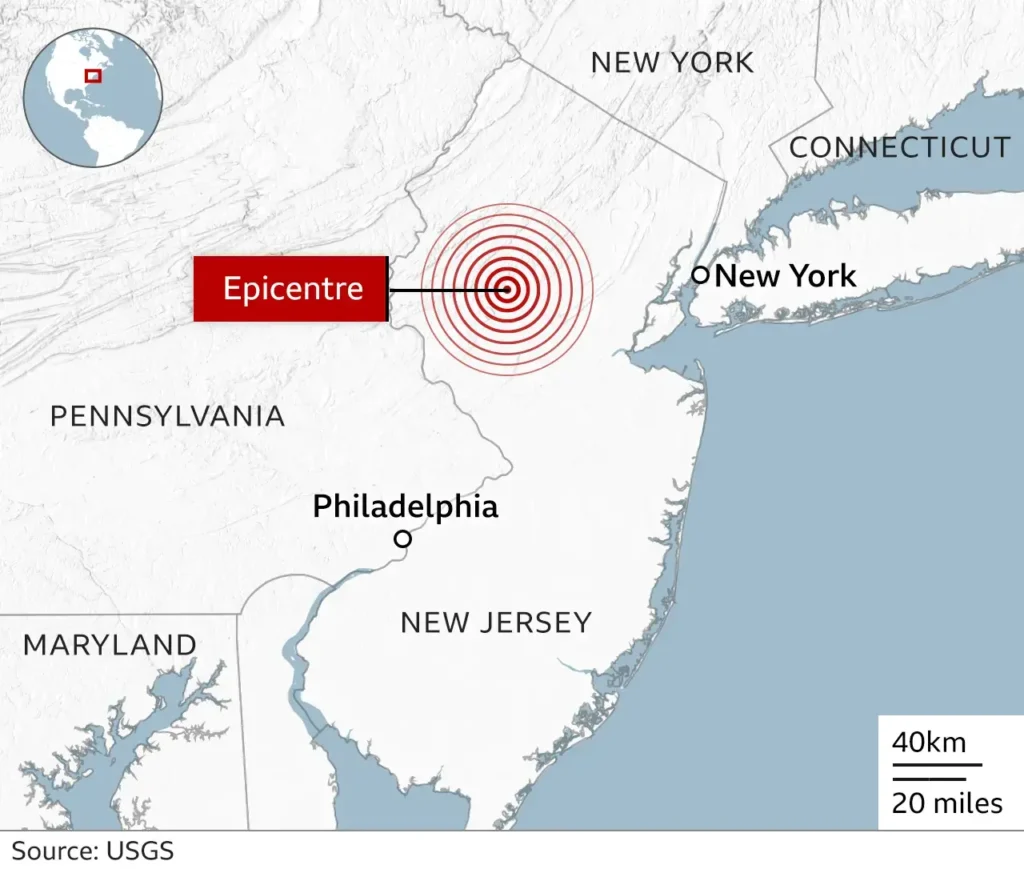East Coast Earthquakes Bless NYC, it was an ordinary Friday morning on the East Coast. The bustle of cities like New York, Philadelphia, and Boston settled into their daily rhythms. But suddenly, at around 10:30 local time, an unexpected jolt rippled through the region. An earthquake, a tremor most often associated with the dramatic tectonic activity of the West Coast, shook the very foundations of New Jersey, sending tremors as far north as Boston and south to Washington, D.C.
While the earthquake’s magnitude of 4.8 wasn’t monumental by West Coast standards, it was a significant event for a region unaccustomed to such activity. The United States Geological Survey (USGS) issued warnings of possible aftershocks, urging residents to brace themselves for further tremors.
A Tale of Two Coasts: Geology Explains the Impact
For many East Coasters, this earthquake served as a wake-up call to the ancient geological forces slumbering beneath their feet. Unlike the ever-shifting tectonic plates and active faults that define the West Coast’s landscape, the East Coast boasts a quieter geological history. Its faults, aged gracefully over millions of years, haven’t experienced the same level of recent activity.
This difference in geological makeup explains why earthquakes on the East Coast can be felt over much larger distances compared to their West Coast counterparts. Imagine the West Coast as a rambunctious teenager, constantly in motion with numerous active faults acting like shock absorbers. In contrast, the East Coast resembles a seasoned citizen – its faults are more static, with less frequent activity, but the energy travels further with less loss through the region’s harder bedrock.
The Mystery of the Ramapo Fault
In the aftermath of the quake, experts scrambled to pinpoint its exact origin. While the specific fault responsible remains unidentified, it is believed to be part of the Ramapo fault system, an ancient geological feature that extends across several states. Unlike the dynamic fault networks of the West Coast, the East Coast’s faults have lain dormant for eons, accumulating potential energy with each passing millennium.
Friday’s earthquake, though relatively minor by seismic standards, served as a stark reminder that even these ancient faults can be reactivated.
Beyond the Shaking: A Spiritual Awakening

The earthquake’s impact extended far beyond the physical tremors. It triggered a wave of introspection and even a sense of gratitude among some residents. Perhaps it was the rarity of the event, a stark reminder of the unpredictable forces of nature that lie just beneath the surface of our seemingly stable world.
Finding Solace in Tradition
One New Yorker’s experience, as described in a competitor’s article, exemplifies this spiritual awakening:
“We are not generally supposed to get earthquakes on the East Coast. But on Friday morning, I found myself looking up the bracha, or blessing, for earthquakes: Blessed are You, Lord our God, King of the universe, whose power and might fill the world. Rarely in my life have I felt an internal need to make a blessing or pray over anything. That changed when my apartment in Brooklyn began to shake.”
In Judaism, earthquakes have long been regarded as manifestations of divine power, moments when the earth itself seems to tremble in awe of its creator. The experience prompted the New Yorker to acknowledge the sacred amidst the chaos, finding solace in a traditional blessing, a prayer of gratitude for the reminder of life’s fragility and resilience.
Community and Resilience in the Face of Uncertainty
Beyond the realm of religion, the earthquake sparked a broader conversation about resilience and community. In a region known for its fast-paced lifestyle, the quake served as a rare moment of collective pause. Neighbors checked on one another, sharing stories of their shared experience. It was a reminder that in the face of uncertainty, it is often our connections with others that provide the greatest source of strength.
Lessons Learned: Preparing for the Future
While Friday’s earthquake may have been a surprise, it serves as a crucial reminder that the East Coast is not immune to seismic activity. Here are some key takeaways to be prepared for future events:
- Be informed: Familiarize yourself with earthquake safety procedures. The USGS website offers a wealth of resources on earthquake preparedness.
- Assemble an emergency kit: This should include non-perishable food, water, first-aid supplies, a flashlight, and a battery-powered radio.
- Secure your home: Heavy objects on shelves should be secured to prevent them from falling during an earthquake.
Living on a Dynamic Planet
Earthquakes are a natural phenomenon, a consequence of the ever-shifting Earth beneath our feet. While the East Coast